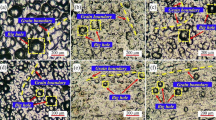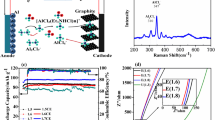Abstract
The aluminum electrolysis spent cathode (SC) was treated by hydrothermal method and used as anode material for lithium-ion battery. The purified SC material shows excellent electrochemical performance. In order to understand the diffusion behavior of Li+ in the SC electrode, the diffusion coefficient of Li+ in the SC electrode was systematically analyzed by galvanostatic intermittent titration technique (GITT), cyclic voltammetry (CV), and electrochemical impedance spectroscopy (EIS). The results show that the diffusion coefficient (\({D}_{{\text{Li}}^{+}}\)) of Li+ in SC electrode is calculated by CV is 2.2292 × 10−11 cm2 s−1, and the ranges calculated by GITT and EIS are 4.2286 × 10−13 − 2.9667 × 10−10 cm2 s−1, 4.05 × 10−13 − 3.87 × 10−12 cm2 s−1, respectively. SC electrode exhibits better Li+ diffusion kinetics compared to commercial graphite (CG). In addition, the full cell of LiNi0.5Co0.2Mn0.3O2/SC also shows excellent cycle performance. After 80 cycles at 1 °C (1 °C = 172 mA g−1), the specific discharge capacity of LiNi0.5Co0.2Mn0.3O2/SC full-cell can reach 94.7 mAh g−1, and the capacity retention can reach 98.13%. The fast lithium-ion diffusion rate and high discharge capacity provide a feasible direction for the high value utilization of aluminum electrolysis spent cathode.








Similar content being viewed by others
Change history
13 January 2022
A Correction to this paper has been published: https://doi.org/10.1007/s11581-022-04454-1
References
Li R B, Lu T T, Xie M Z, Liu F Q (2020) Analysis on thermal behavior of fluorides and cyanides for heat-treating spent cathode carbon blocks from aluminum smelters by TG/DSC-MS & ECSA(R). Ecotoxicol Environ Saf 189: 110015
Wang YW, Peng JP, Di YZ (2018) Separation and recycling of spent carbon cathode blocks in the aluminum industry by the vacuum distillation process. Jom 70:1877–1882
Wang YF, Chen XP (2020) Discussion on recycling of spent cathode carbon blocks from aluminum smelters. Light Metals 5:31–35
Yuan W, Jin ZQ, Yang Y (2012) The process mineralogy research on aluminum electrolysis waste cathode. Yunnan Metallurgy 41:64–68
Chen B S, Yang W Z, Yang J X, Wang C S, Jiang J (2018) Experimental study on treatment of aluminum reduction waste cathode carbon blocks by combustion method. Light Metals 35–39
Wang JL, Liu HY, Luo YF, Niu QR, He H, Shen SF (2012) Study on harmless and resources recovery treatment technology of waste cathode carbon blocks from electrolytic aluminum. Procedia Environ Sci 16:769–777
Nguyen VH, Jin EM, Gu HB (2013) Synthesis and electrochemical properties of LiFePO4-graphite nanofiber composites as cathode materials for lithium ion batteries. J Power Sources 244:586–591
Yu J, Peng J X, Huang W L, Wang L J, Wei Y B, Yang N X, Li L B (2021) Inhibition of excessive SEI-forming and improvement of structure stability for LiNi0.8Co0.1Mn0.1O2 by Li2MoO4 coating. Ionics
Sharma Y, Sharma N, Rao G, Chowdari B (2010) Nanophase ZnCo2O4 as a high performance anode material for Li-ion batteries. Adv Func Mater 17:2856–2861
Zhang G, Le Y, Hao BW, Hoster HE, Xiong WL (2012) Formation of ZnMn2O4 ball-in-ball hollow microspheres as a high-performance anode for lithium-ion batteries. Adv Mater 24:4609–4613
Zhu X, Jian X, Luo Y, Fu Q, Liang G, Luo L, Chen Y, Lin C, Zhao X S (2019) MoNb12O33 as a new anode material for high-capacity, safe, rapid and durable Li+ storage: structural characteristics, electrochemical properties and working mechanisms. Journal of Materials Chemistry A 7:
Fu Q, Zhu X, Li R, Liang G, Zhao XS (2020) A low-strain V3Nb17O50 anode compound for superior Li+ storage. Energy Storage Materials 30:401–411
Ding ZY, Li XC, Wei TR, Yin ZL, Li XH (2016) Improved compatibility of graphite anode for lithium ion battery using sulfuric esters. Electrochim Acta 196:622–628
Lv C P, Ca G S, Zhao X B, Zhu T J (2000) Effects of graphite on Zn-Sb alloys as anode materials for lithium ion batteries. Transactions of Nonferrous Metals Society of China 77–81
Zhang PC, Yuan T, Pang YP, Peng CX, Yang JH, Ma ZF, Zheng SY (2019) Influence of current density on graphite anode failure in lithium-ion batteries. J Electrochem Soc 166:A5489–A5495
Yang K, Zhao ZJ, Xin X, Tian ZL, Peng K, Lai YQ (2019) Graphitic carbon materials extracted from spent carbon cathode of aluminium reduction cell as anodes for lithium ion batteries: Converting the hazardous wastes into value-added materials. J Taiwan Inst Chem Eng 104:201–209
Liu X L, Wang S, Wang L, Wang K, Wu X Z, Zhou P F, Miao Z C, Zhou J, Zhao Y, Zhuo S P (2019) Stabilizing the high-voltage cycle performance of LiNi0.8Co0.1Mn0.1O2 cathode material by Mg doping. Journal of Power Sources 438: 227017
Maurin G, Bousquet C, Henn F, Simon B (1999) Determination of the chemical diffusion coefficient of lithium in multiwall carbon nanotubes. Ionics 5:156–160
Liu PC, Xiao L, Chen YF, Chen H (2019) Highly enhanced electrochemical performances of LiNi0.815Co0.15Al0.035O2 by coating via conductively LiTiO2 for lithium-ion batteries. Ceram Int 45:18398–18405
Prosini PP, Lisi M, Zane D, Pasquali M (2012) Determination of the chemical diffusion coefficient of lithium in LiFePO4. Solid State Ionics 148:45–51
Tang AP, Wang XY, Xu GR, Zhou ZH, Nie HD (2009) Determination of the chemical diffusion coefficient of lithium in Li3V2(PO4)3. Mater Lett 63:1439–1441
Yang K, Gong P Y, Tian Z L, Lai Y Q, Li J (2020) Recycling spent carbon cathode by a roasting method and its application in Li-ion batteries anodes. Journal of Cleaner Production 261: 121090
Zou LH, Huang BY, Huang Y, Huang QZ, Wang C, a, (2003) An investigation of heterogeneity of the degree of graphitization in carbon–carbon composites. Mater Chem Phys 82:654–662
Wang H, Yang G, Chen Z, Liu J, Fan X, Liang P, Huang Y, Lin J, Shen Z (2019) Nitrogen configuration dependent holey active sites toward enhanced K+ storage in graphite foam. J Power Sources 419:82–90
Chen DD, He ZQ, Wang M, Wu D, Chen XY, Zhang ZJ (2020) Boron doping and structure control of carbon materials for supercapacitor application: the effect of freeze-drying and air-drying for porosity engineering. J Solid State Electrochem 24:641–654
Liu K, Yang S L, Luo L Q, Pan Q C, Zhang P, Huang Y G, Zheng F H, Wang H Q, Li Q Y (2020) From spent graphite to recycle graphite anode for high-performance lithium ion batteries and sodium ion batteries. Electrochimica Acta 356: 136856
Zhu TH, Hu QY, Yan GC, Wang JX, Wang ZX, Guo HJ, Li XH, Peng WJ (2019) Manipulating the composition and structure of solid electrolyte interphase at graphite anode by adjusting the formation condition. Energ Technol 7:1900273
Park YS, Lee SM (2009) Effects of particle size on the thermal stability of lithiated graphite anode. Electrochim Acta 54:3339–3343
Yang Y, Peng WJ, Guo HJ, Wang ZX, Li XH, Zhou YY, Liu YJ (2007) Effects of modification on performance of natural graphite coated by SiO2 for anode of lithium ion batteries. Transactions of Nonferrous Metals Society of China 17:1339–1342
Liao X Q, Ding Z Y, Yin Z L (2020) Excellent performance of a modified graphite anode for lithium-ion battery application. Ionics 5367–5373
He M, Zhou H, Ding G, Zhang Z, Ye X, Cai D, Wu M (2019) Theoretical-limit exceeded capacity of the N2+H2 plasma modified graphite anode material. Carbon 146:194–199
Tang K, Yu XQ, Sun JP, Li H, Huang XJ (2011) Kinetic analysis on LiFePO4 thin films by CV, GITT, and EIS. Electrochim Acta 56:4869–4875
Wu L P, Tang X C, Chen X, Rong Z H, Dang W, Wang Y, Li X, Huang L C, Zhang Y (2020) Improvement of electrochemical reversibility of the Ni-rich cathode material by gallium doping. Journal of Power Sources 445: 227337
Yu J, Huang WL, Meng BC, Wang LJ, Zhao JK, Li LB, Du XQ, Fang Z (2019) Enhanced rate performance and high current cycle stability of LiNi0.8Co0.1Mn0.1O2 by sodium doping. Mater Express 9:895–905
Fan XY, Ni K, a, Han J X, Wang S, Gou L, Li D L, (2019) Cathodic electrodeposition of porous MnO2 film as binder-free cathode for high performance rechargeable Zinc-ion battery. Funct Mater Lett 12:1950073
Kim HR, Choi WM (2018) Graphene modified copper current collector for enhanced electrochemical performance of Li-ion battery. Scripta Mater 146:100–104
Gong XH, Zheng YB, Zheng J, Cao SP, Wen H, Lin BP, Sun YM (2020) Surface-sunctionalized graphite as long cycle life anode materials for lithium-ion batteries. ChemElectroChem 7:1465–1472
Chen QC, Yan GJ, Luo LM, Chen F, Xie TF, Dai SC, Yuan ML (2018) Enhanced cycling stability of Mg-F co-modified LiNi0.6Co0.2Mn0.2-yMgyO2-zFz for lithium-ion batteries. Transactions of Nonferrous Metals Society of China 028:1397–1403
Babulal L M, Yang C C, Wu S H, Chien W C, Jose R, Jessie Lue S J (2020) Enhanced performance of a Ni-rich LiNi0.8Co0.1Mn0.1O2 cathode material formed through taylor flow synthesis and surface modification with Li2MoO4. Chemical Engineering Journal 127150
Qu XY, Yu ZL, Ruan DS, Dou AC, Su MR, Zhou Y, Liu YJ, Chu DW (2020) Enhanced electrochemical performance of Ni-rich cathode materials with Li1.3Al0.3Ti1.7(PO4)3 coating. ACS Sustainable Chemistry & Engineering 8:5819–5830
Lai J, Guo H J, Li X Q, Wang Z X, Li X H, Zhang X P, Huang S L, Gan L (2013) Silicon/flake graphite/carbon anode materials prepared with different dispersants by spray-drying method for lithium ion batteries. Transactions of Nonferrous Metals Society of China 1413–1420
Peng J X, Zhong K N, Huang W L, Hou X Y, Gao H Q, Fang Z, Li L B (2021) Regulation of an inner helmholtz plane by hierarchical porous biomass activated carbon for stable cathode electrolyte interphase films. Vacuum 191: 110331
Acknowledgements
This work was supported by the National Natural Science Foundation of China (52034011, 51974219), Natural Science Basic Research Plan in Shaanxi Province (2018JM5135). The authors would like to thank Shiyanjia Lab (www.shiyanjia.com) for the XRD and Raman analysis.
Author information
Authors and Affiliations
Corresponding author
Ethics declarations
Conflict of interest
The authors declare that they have no conflict of interest.
Additional information
Publisher's note
Springer Nature remains neutral with regard to jurisdictional claims in published maps and institutional affiliations.
Rights and permissions
About this article
Cite this article
Huang, W., Peng, J., Li, J. et al. Diffusion coefficient analysis of aluminum electrolysis spent cathode as anode material for lithium-ion battery. Ionics 28, 961–971 (2022). https://doi.org/10.1007/s11581-021-04398-y
Received:
Revised:
Accepted:
Published:
Issue Date:
DOI: https://doi.org/10.1007/s11581-021-04398-y




